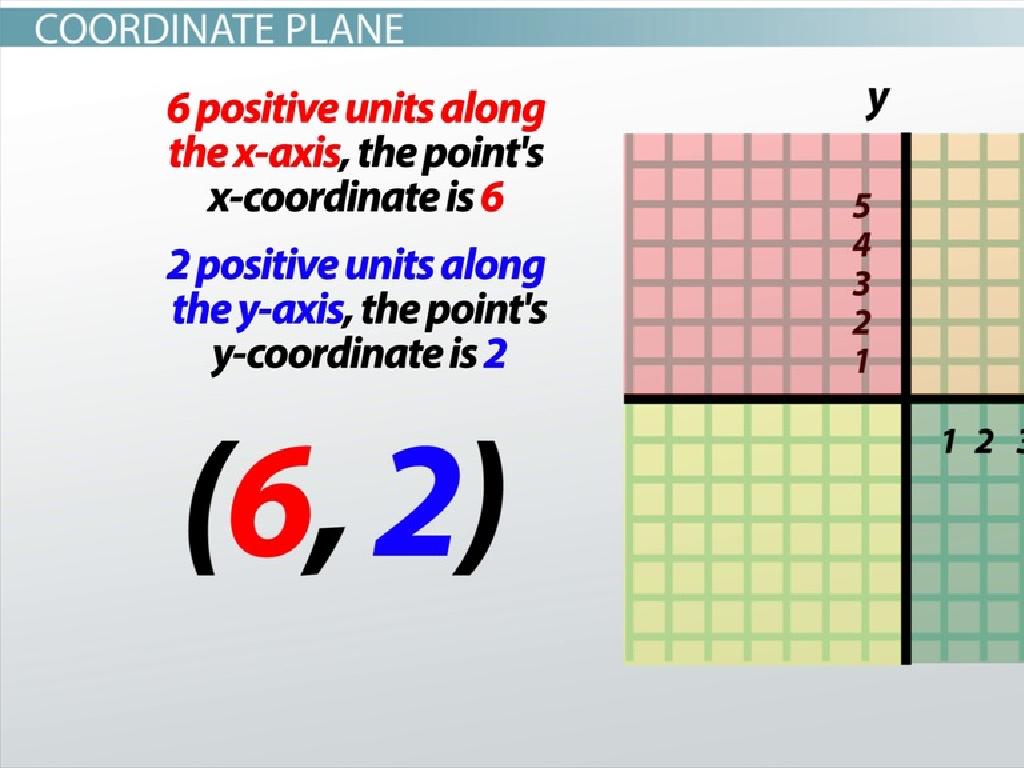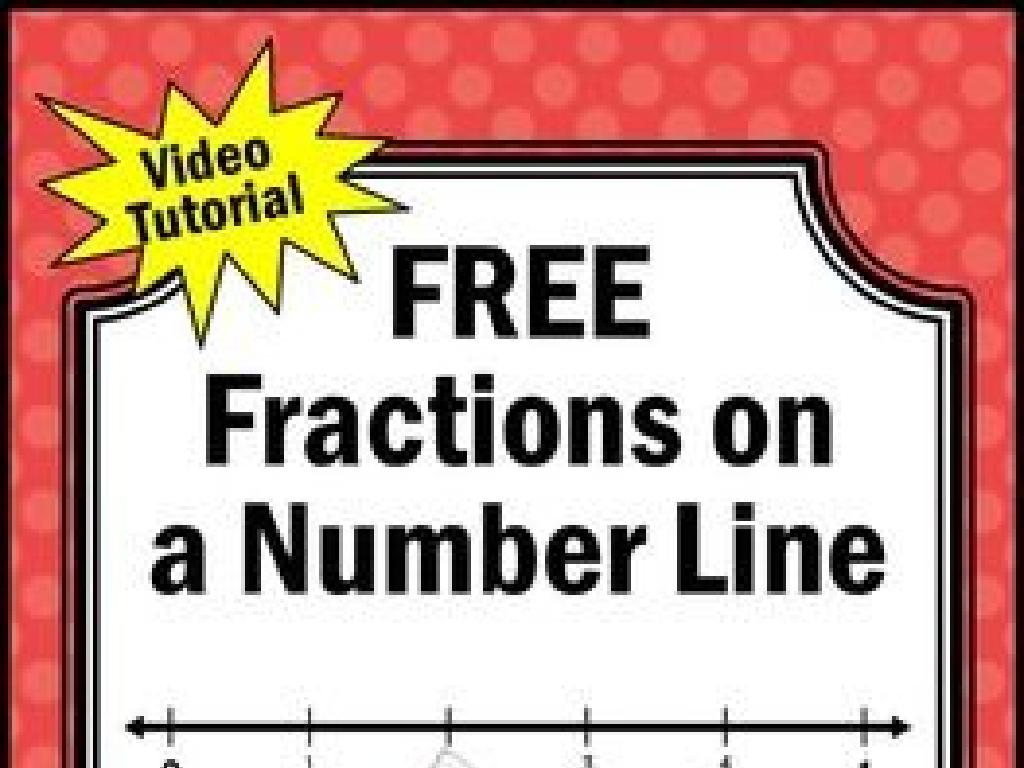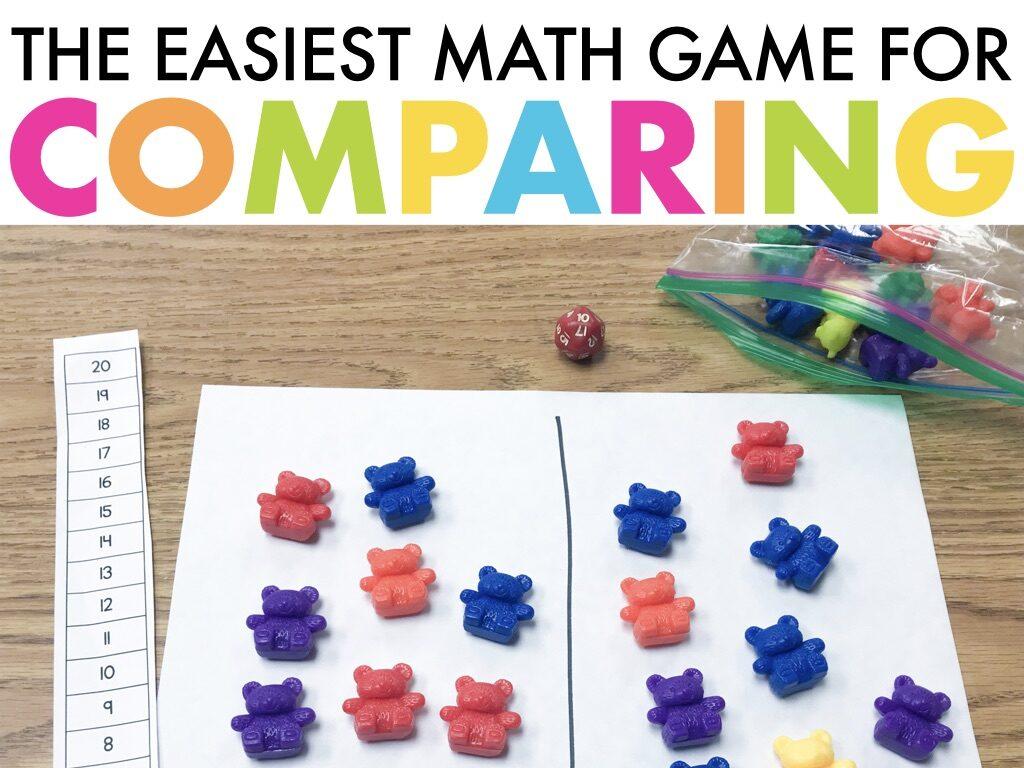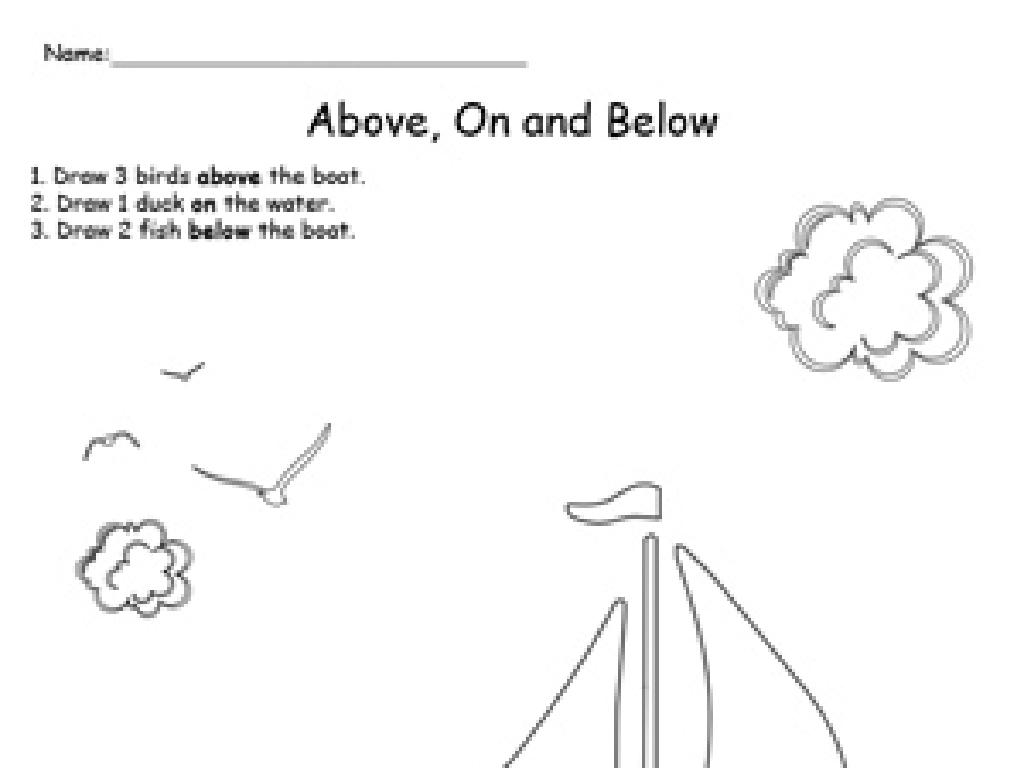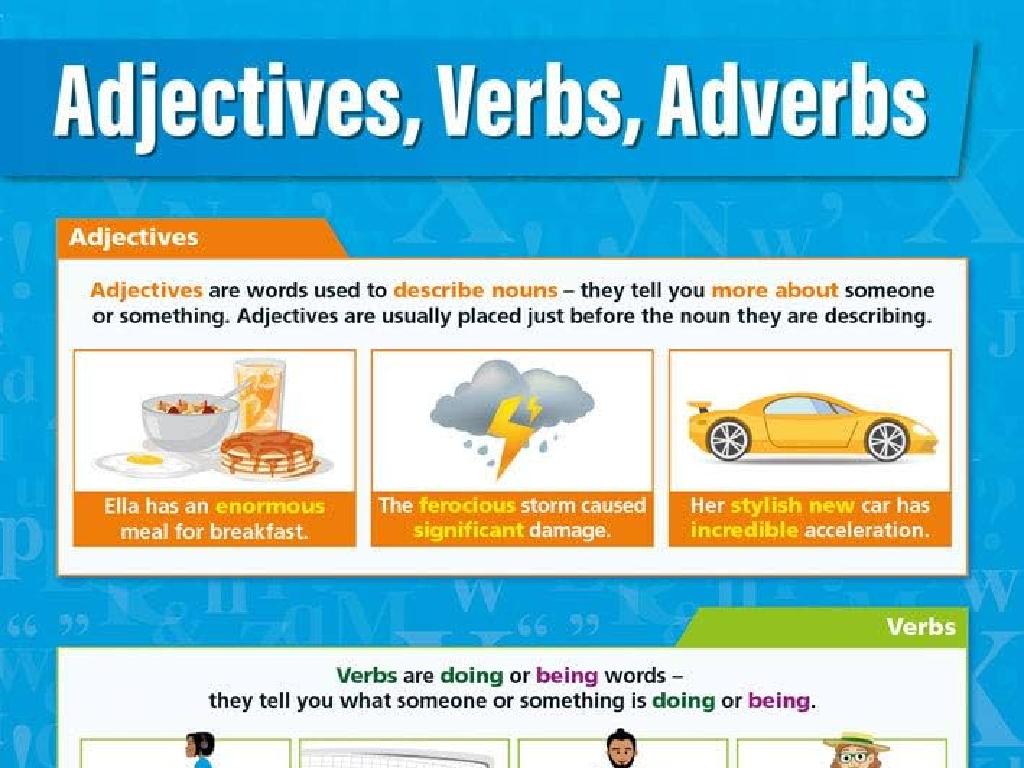Convert Mixed Numbers To Decimals
Subject: Math
Grade: Fifth grade
Topic: Convert Between Decimals And Fractions
Please LOG IN to download the presentation. Access is available to registered users only.
View More Content
Understanding Fractions and Decimals
– Fractions to decimals concept
– Learn how to convert fractions into decimal form
– Decimals and fractions as parts
– Both represent equal parts of a whole number
– Everyday examples
– Money and measurements are common examples
– Practice conversion
|
Begin the lesson by explaining that both fractions and decimals are ways to represent numbers that are not whole. Emphasize that a fraction like 1/2 and a decimal like 0.5 are two ways of representing the same quantity. Use everyday examples such as money (quarters as 0.25) and measurements (a half inch as 0.5) to illustrate the concept. This will help students relate to the material and understand its practical applications. After the introduction, guide students through the process of converting fractions with denominators of 10 or 100 into decimals, and then extend to other fractions by dividing the numerator by the denominator. Provide practice problems for students to solidify their understanding.
Understanding Mixed Numbers
– Define mixed numbers
– A whole number and a fraction combined, like 2 1/2
– Mixed numbers in real life
– Used in cooking, measuring, and time tracking
– Visualize mixed numbers
– Draw a number line or pie charts to show 3 3/4
– Practice with examples
– Convert 1 1/2 to a decimal as a class activity
|
Begin by defining mixed numbers as the sum of a whole number and a fraction. Provide relatable examples such as recipes in cooking (e.g., 2 1/2 cups of flour), measurements in construction (e.g., 5 3/8 inches of wood), or time (e.g., 1 1/2 hours). Use visual aids like number lines or pie charts to help students grasp the concept of mixed numbers. For instance, show how 3 3/4 can be represented on a number line or as three full pies and one that is three-quarters full. Engage the class with an example, converting 1 1/2 into a decimal, and encourage them to visualize the process. This will prepare them for the next step of converting mixed numbers to decimals.
Understanding Decimals
– What are decimals?
– Decimals represent parts of a whole number.
– Decimal place values
– Each place after the decimal has a value: tenths, hundredths, etc.
– Decimals vs. fractions
– Decimals and fractions both show parts of whole numbers.
– Converting mixed numbers
– Mixed numbers have a whole number and a fraction part.
|
This slide introduces the concept of decimals to fifth graders. Begin by explaining that decimals are another way to represent fractions and parts of a whole, similar to money (0.25 is like a quarter of a dollar). Discuss the place value system in decimals, emphasizing the tenths, hundredths, and thousandths places. Compare decimals to fractions to show the relationship between the two, using visual aids like pie charts or number lines if possible. Finally, explain how to convert mixed numbers to decimals by converting the fraction part to a decimal and adding it to the whole number. Provide examples and practice problems to reinforce the concept.
Converting Mixed Numbers to Decimals
– Steps to make improper fractions
– Multiply the whole number by the denominator, add the numerator
– Why start with improper fractions
– It simplifies the conversion to decimals
– Class practice example
– Let’s convert 3 4/5 together
– Discuss conversion process
|
Begin by explaining the process of converting a mixed number to an improper fraction: multiply the whole number by the denominator and add the numerator. Emphasize the importance of this step as it makes the subsequent conversion to decimals straightforward. Work through a practice example as a class, such as converting 3 4/5 to an improper fraction and then to a decimal. This will help students understand the process and see how each step leads to the final decimal form. Encourage students to ask questions and provide additional examples if needed to ensure understanding.
Converting Improper Fractions to Decimals
– Divide numerator by denominator
– Grasp the concept of long division
– Long division is breaking up the division into manageable steps
– Example: Convert improper fraction
– 7/4 becomes 1.75 after division (7 ÷ 4)
– Practice with different fractions
– Try converting 9/5 or 11/3 to decimals
|
This slide introduces the process of converting improper fractions to decimals, which is a key concept in understanding the relationship between fractions and decimals. Start by explaining that the numerator (top number) can be divided by the denominator (bottom number) to get a decimal. Then, teach the students the method of long division, which they will use to divide larger numbers. Use the example of 7 divided by 4 to show how an improper fraction is converted into a decimal. Finally, encourage the students to practice this skill by converting other improper fractions, such as 9/5 or 11/3, into decimals. Make sure to provide step-by-step guidance and check for understanding throughout the lesson.
Converting Mixed Numbers to Decimals
– Convert mixed to improper fraction
– Combine the whole number and fraction parts into one fraction
– Change improper fraction to decimal
– Divide the numerator by the denominator to get a decimal
– Work through an example together
– Example: Convert 3 3/4 to an improper fraction, then to a decimal
– Understand the importance of this skill
– Knowing this helps in math and real-life situations, like measuring
|
This slide aims to guide students through the process of converting mixed numbers to decimals. Start by explaining how to turn a mixed number into an improper fraction by multiplying the denominator by the whole number and adding the numerator. Next, show how to convert the improper fraction to a decimal by dividing the numerator by the denominator. Work through a class example, such as converting 3 3/4 to a decimal. Discuss with the class why this skill is important, emphasizing its practical applications in everyday life, such as in cooking or measuring distances. Encourage students to think of other situations where this conversion might be necessary.
Practice Time: Mixed Numbers to Decimals
– Convert mixed numbers individually
– Pair up to compare answers
– Discuss challenges in groups
– What difficulties did you face?
– Share strategies for conversion
– Did you use long division or another method?
|
This slide is designed for student engagement and interaction. Begin with individual practice where students convert mixed numbers to decimals on their own. Encourage them to work through the problems step-by-step. Afterward, students will pair up to compare their answers and methods, fostering peer learning. Then, bring the class together for a group discussion to talk about any challenges they encountered and to share different strategies for conversion. This could include understanding the place value system or using long division. The teacher should circulate during activities, provide guidance, and ensure that each student is participating and understanding the conversion process. Possible activities: 1) Convert 2 3/4 to a decimal. 2) Convert 5 1/2 to a decimal. 3) Convert 7 3/8 to a decimal. 4) Convert 4 2/5 to a decimal.
Class Activity: Decimal Scavenger Hunt
– Find objects with mixed numbers
– Convert mixed to decimals
Use division to change fractions to decimals
– Share findings with class
– Explain your conversion
Describe steps taken to convert numbers
|
This interactive activity is designed to help students apply their knowledge of converting mixed numbers to decimals in a fun and engaging way. Students will search the classroom for objects that have mixed numbers on them, such as rulers or textbooks. Once they find an object, they should write down the mixed number and convert it into a decimal using the skills they’ve learned. After the hunt, students will share their findings with the class, explaining the conversion process step by step. For the teacher: Prepare a list of objects with mixed numbers beforehand to ensure a smooth activity. Guide students through the conversion process if they struggle, and have additional examples ready for demonstration. Encourage students to explain their thought process during the sharing phase to reinforce their understanding.
Wrapping Up: Mixed Numbers to Decimals
– Recap of conversion steps
– Why conversions are important
– Converting forms helps in everyday math like shopping or cooking
– Homework: Conversion worksheet
– Worksheet includes 10 problems to solve
– Practice makes perfect!
|
As we conclude today’s lesson, remind the students of the step-by-step process we’ve learned for converting mixed numbers to decimals. Emphasize the real-world applications of this skill, such as understanding measurements in cooking or calculating money. For homework, students are assigned a worksheet with 10 problems to reinforce their understanding and practice the conversion process. Encourage them to try their best and remind them that making mistakes is a part of learning. The next class will begin with a review of the homework to address any challenges students faced.

